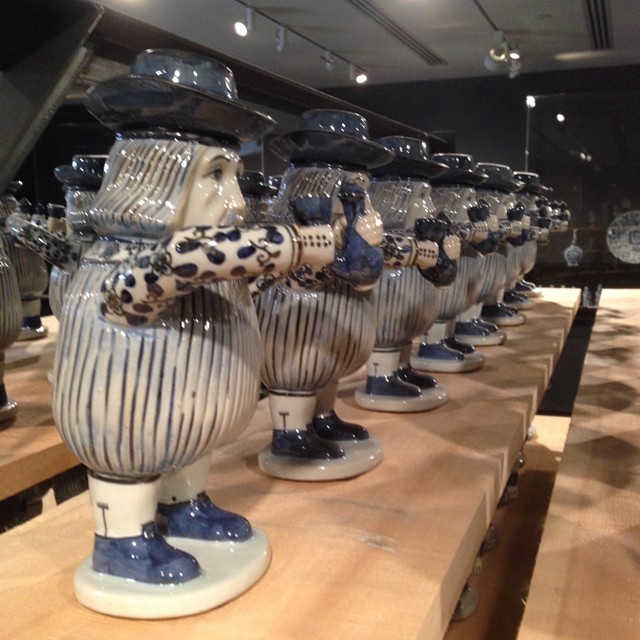Moving Out of the Comfort Zone

It’s Way Past Time to Mix Things Up.
(Mr. Nobody, Freeport [No. 005], Michael Lin, Peabody Essex Museum, Salem, MA)
I came across a word recently and stuck it in a draft post to save for a later blog. I’ve just returned to it now. I can’t remember where I saw it but it still seems worthy of a post. The word is “homophily.” It translates to “love of the same” or “the tendency of individuals to associate and bond with similar others.” Although the word encompasses homosexuality of course, it’s the much broader scope of it that I find interesting.
In a 2006 New York Times article, author Aaron Retica notes that sociologists coined the term “homophily” in the 1950s. “The term didn’t catch on,” he writes, “but the concept is now enjoying a renaissance, in part because it has been repeatedly invoked to explain the American electorate’s apparent polarization into equally self-regarding camps.” Retica mentions a 2001 study titled “Birds of a Feather: Homophily in Social Networks.” In it, the authors sum up the nature and the harm of this tendency in their abstract:
Similarity breeds connection. This principle—the homophily principle—structures network ties of every type, including marriage, friendship, work, advice, support, information transfer, exchange, comembership, and other types of relationship. The result is that people’s personal networks are homogeneous with regard to many sociodemographic, behavioral, and intrapersonal characteristics. Homophily limits people’s social worlds in a way that has powerful implications for the information they receive, the attitudes they form, and the interactions they experience. Homophily in race and ethnicity creates the strongest divides in our personal environments, with age, religion, education, occupation, and gender following in roughly that order.
This goes back in essence to the monkey sphere I wrote about earlier. Not only do we interact mainly with a very limited number of people, but they also tend to be very much like us. Even in “wider” networks like social media, we still tend to hang with “birds of a feather” and react with reservation and sometimes outright suspicion and fear to anyone who falls outside of that group.
The other day I was in Home Depot shopping when a young man came up to me and introduced himself. He was promoting a store special on kitchen designs and upgrades. He had a great smile, was neatly attired in blazer and tie, and was very friendly in manner. He was also stereotypically Arabic in appearance with dark skin, black hair, and a full black beard. My first reaction, shamefully, was to recoil, just mentally I hope, with all the thoughts of terrorists and their horrible actions. My second reaction, almost as shamefully, was to overcompensate for my first reaction by engaging in conversation and listening to his pitch even though I wasn’t interested in a new kitchen. How sad that such behavior gets ingrained to the point where we have knee-jerk instinctive responses in spite of our fervent conscious desire not to have them.
In his NYT piece, Retica mentions an article by Nat Torkington called “Homophily in Social Software.” Torkington notes that “homophily raises the question for social software designers of how much they should encourage homophily and how much they want to mix it up.” He recommends ways in which social media users can break the homophily trap and work more toward serendipity. This would be especially useful in today’s political world. In his Washington Post article “Why Everyone You Know Thinks the Same as You,” Shankar Vendatum quotes sociologist Mario Small:
“Most of us would be hard-pressed to provide clear explanations for our political beliefs,” said Small. “If you ask the average person why they believe what they believe on Roe v. Wade, you are not going to get a coherent answer. We participate in settings where we don’t have to explain ourselves because everyone else agrees with us. What this means is, ‘I have no reason to challenge or question my own beliefs.'”
One of President Obama’s campaign slogans, before the Washington quagmire sucked him under, was “Be the Change.” It’s way past time for us to make that happen. We have friends on the opposite side of the political spectrum with whom we have a mutual agreement not to talk about politics. I think we should break that agreement now with them and everyone else. Somewhere in the midst of all our conflicting beliefs and the myriad misconceptions that come from homophily and cable news must be some common ground to stand together on. Here’s hoping we find it.
~~~~~~~~~~~~~
Visit Kim Pederson’s blog RatBlurt: Mostly Random Short-Attention-Span Musings

Homophily is the natural order of things. It only becomes problematic when through religion, education, and media mind control, people become indoctrinated to believe that their race, their religion, their gender, their political beliefs are chosen by the Creator above all others. Birds of a feather naturally flock together but you don’t see them standing on hilltops cheering on the mass murder of their different feather colored Aves. This behavior is psychopathic and akin to a virus which must be isolated and stopped from spreading IMMEDIATELY .
We get used to our own smell, the way a cat lady with fifteen cats and several dirty litter boxes thinks the living room smells fine. Thanks, Kim…Enlightening as always 🙂